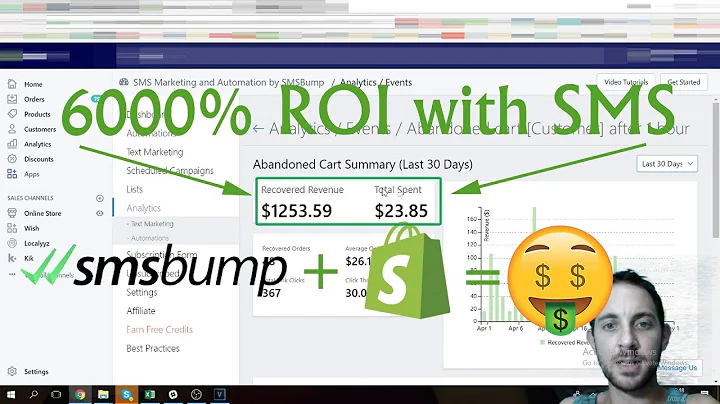Discover Dropshipping Suppliers and Shopify
Table of Contents
- Introduction to dropshipping Suppliers
- Researching Reputable Suppliers
- Evaluating Suppliers based on Criteria
- Building Relationships with Suppliers
- Integrating Supplier Catalog into Shopify Store
- Monitoring Supplier Performance
- Maintaining Communication with Suppliers
- Introduction to Shopify and its Features
- Customization with Shopify Themes
- Ease of Use with Shopify
- Dropshipping Integration with Shopify
- Subscription Tiers in Shopify
- Payment Options in Shopify
- Conclusion
Article
Introduction to Dropshipping Suppliers
Dropshipping suppliers play a crucial role in the success of a dropshipping business. They are responsible for shipping products to customers on behalf of the business owner, allowing them to focus on running the business smoothly. Finding trustworthy suppliers is essential for a successful dropshipping business. Researching reputable suppliers within your chosen niche is a good starting point. Shopify offers an extensive directory of suppliers and apps that can connect you with a wide range of products.
Researching Reputable Suppliers
When researching suppliers, it is important to look for those with positive reviews, clear communications, and a track record of timely deliveries. Factors such as product quality, shipping times, return policies, and pricing should also be considered. Checking the responsiveness to inquiries and willingness to provide product samples are additional aspects to keep in mind. Establishing a solid supplier partnership sets the stage for long-term success.
Evaluating Suppliers based on Criteria
After narrowing down the list of potential suppliers, it is time to evaluate them based on specific criteria. This includes testing their services and product quality by placing simple orders. It is crucial to assess shipping times, packaging, and the overall customer experience. This evaluation helps determine if the supplier aligns with the business standards and meets customer expectations.
Building Relationships with Suppliers
Once reliable suppliers are identified, it is important to reach out and start building relationships. Introduce yourself, express interest in their products, and discuss partnership terms. Inquire about their dropshipping policies, minimum order quantities, and any additional fees. Effective communication and relationship building are essential for a successful supplier partnership.
Integrating Supplier Catalog into Shopify Store
After finding a reliable supplier, the next step is to integrate their product catalog into the Shopify store. Utilize the user-friendly interface of Shopify to import product listings, images, and descriptions. Organize your store by categorizing products according to suppliers and optimize product pages for search engines. This ensures a seamless and efficient shopping experience for customers.
Monitoring Supplier Performance
Continuously monitoring supplier performance is crucial. Keep track of product availability, customer feedback, and supplier responsiveness. Promptly address any issues that arise and provide constructive feedback to suppliers. Maintaining open lines of communication and addressing any concerns promptly helps ensure a smooth and successful dropshipping operation.
Maintaining Communication with Suppliers
Regular and open communication with suppliers is essential. Establish a communication plan and address any inquiries or concerns promptly. Building strong relationships through effective communication helps foster trust and understanding between the business owner and the supplier. Providing feedback and suggestions for improvement also contributes to long-term success.
Introduction to Shopify and its Features
Shopify is a powerful e-commerce platform that offers numerous features for building and managing an online store. It stands out from other platforms due to its extensive customization options and ease of use. Shopify has a vast library of both free and paid themes that help businesses stand out visually.
Customization with Shopify Themes
Shopify's theme library allows users to browse through various template options and choose the one that best suits their business. The user-friendly editing menu enables adding or removing different sections of the templates. The drag-and-drop feature allows for seamless swapping of website components, providing more control over the creation process. With access to over 20,000 stock images, website creation becomes easier, especially for smaller businesses.
Ease of Use with Shopify
Shopify caters to individuals and businesses of all skill levels, making it a universal choice for most people. It takes care of the technicalities of website building, including hosting, maintenance, and other tasks typically associated with building an online store. Uploading products and customizing the website is made simple, without the need for extensive technical knowledge.
Dropshipping Integration with Shopify
Shopify offers seamless integration with dropshipping. By linking suppliers to the Shopify store, their products, quantities, and descriptions are automatically uploaded. Shopify also handles stock management, displaying "sold out" to customers when items are out of stock. Various collections and sub-collections can be created with ease. Shopify's built-in analytics section provides valuable data to assess the performance of the online store.
Subscription Tiers in Shopify
Shopify offers different subscription tiers tailored to businesses of all sizes. The Basic Shopify tier is suitable for small businesses and provides all the essential features to start an online store. As the subscription tiers increase, additional features become available. The Shopify and Advanced Shopify tiers offer more customization options, higher staff account limits, and advanced reporting capabilities. Shopify also offers customizable tiers, such as Shopify Plus, for larger businesses seeking unlimited staff accounts and personalized support.
Payment Options in Shopify
Shopify's payment system does not charge a percentage of each transaction. Instead, a two percent fee is charged when payments are made through third-party payment services integrated with the platform. Shopify Payments, Shop Pay, Shop Pay Installments, and PayPal Express do not incur third-party transaction fees. Manual payment methods, such as cash on delivery and bank transfers, may incur transaction fees. Shopify provides flexibility and convenience in managing payment options.
Conclusion
Shopify is the ultimate e-commerce platform, offering a multitude of features and benefits for businesses of all sizes. With its extensive customization options, ease of use, dropshipping integration, and flexible payment options, Shopify stands out as the top choice for building and managing online stores. Whether you're a small business just starting out or a large enterprise, Shopify has a subscription tier that fits your needs and preferences. Start your online business journey with Shopify and experience the power of e-commerce.






















